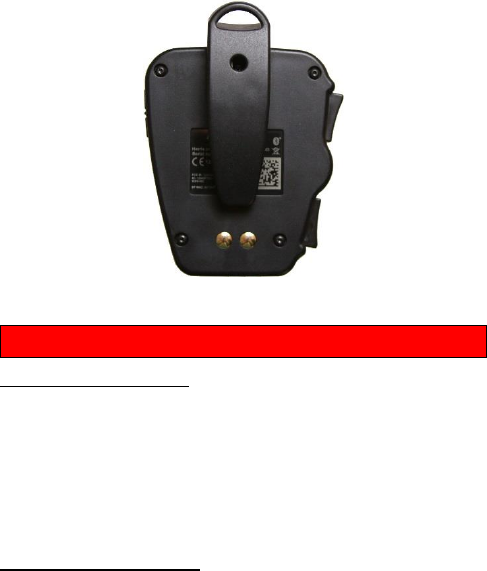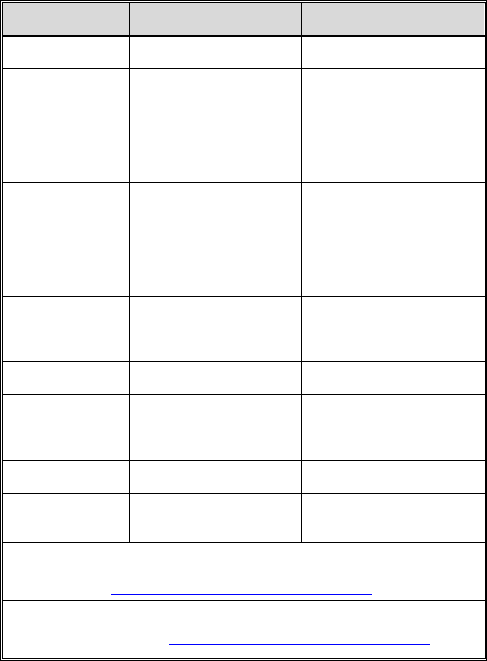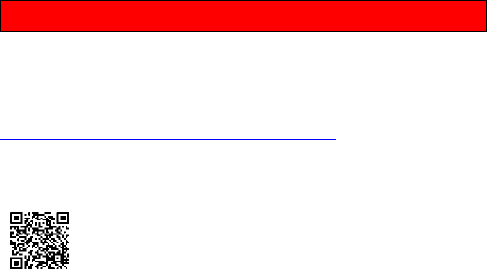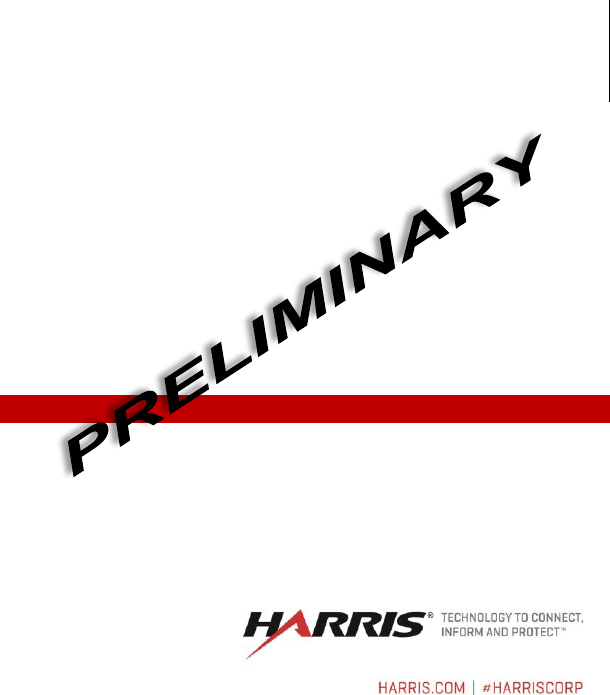HARRIS TR-0142-E Harris Bluetooth Remote Speaker Mic User Manual
HARRIS CORPORATION Harris Bluetooth Remote Speaker Mic
HARRIS >
User Manual

2 14221-1600-1010
MANUAL REVISION HISTORY
REV.
DATE
REASON FOR CHANGE
-
May/16
Initial release.
CREDITS
Harris and BeOn are registered trademarks and TECHNOLOGY TO CONNECT,
INFORM AND PROTECT is a trademark of Harris Corporation.
All brand and product names are trademarks, registered trademarks, or service marks of
their respective holders.
NOTICE!
The material contained herein is subject to U.S. export approval. No export or re-
export is permitted without written approval from the U.S. Government. Rated:
EAR99 in accordance with U.S. Dept. of Commerce regulations 15CFR774, Export
Administration Regulations.
Repairs to this equipment should be made only by an authorized service technician or
facility designated by the supplier. Any repairs, alterations or substitution of
recommended parts made by the user to this equipment not approved by the
manufacturer could void the user’s authority to operate the equipment in addition to
the manufacturer’s warranty.
This product conforms to the European Union WEEE Directive
2012/19/EU. Do not dispose of this product in a public landfill. Take
it to a recycling center at the end of its life.
This manual is published by Harris Corporation without any warranty. Improvements and changes
to this manual necessitated by typographical errors, inaccuracies of current information, or
improvements to programs and/or equipment, may be made by Harris Corporation at any time and
without notice. Such changes will be incorporated into new editions of this manual. No part of this
manual may be reproduced or transmitted in any form or by any means, electronic or mechanical,
including photocopying and recording, for any purpose, without the express written permission of
Harris Corporation.
Copyright © 2016, Harris Corporation.

14221-1600-1010 3
REGULATORY
FCC Part 15
15.21
You are cautioned that changes or modifications not expressly approved by
the part responsible for compliance could void the user’s authority to operate
the equipment.
15.105(b)
This equipment has been tested and found to comply with the limits for a
Class B digital device, pursuant to part 15 of the FCC rules. These limits are
designed to provide reasonable protection against harmful interference in a
residential installation. This equipment generates, uses and can radiate radio
frequency energy and, if not installed and used in accordance with the
instructions, may cause harmful interference to radio communications.
However, there is no guarantee that interference will not occur in a particular
installation. If this equipment does cause harmful interference to radio or
television reception, which can be determined by turning the equipment off
and on, the user is encouraged to try to correct the interference by one or
more of the following measures:
Reorient or relocate the receiving antenna.
Increase the separation between the equipment and receiver.
Connect the equipment into an outlet on a circuit different from that to
which the receiver is connected.
Consult the dealer or an experienced radio/TV technician for help.
Operation is subject to the following two conditions:
1) this device may not cause interference and
2) this device must accept any interference, including interference that may
cause undesired operation of the device.
FCC RF Radiation Exposure Statement:
This equipment complies with FCC radiation exposure limits set forth for an
uncontrolled environment. End users must follow the specific operating
instructions for satisfying RF exposure compliance. This transmitter must
4 14221-1600-1010
not be co-located or operating in conjunction with any other antenna or
transmitter.
Industry Canada
1. This device complies with Industry Canada license-exempt RSS
standard(s). Operation is subject to the following two conditions: (1)
this device may not cause interference, and (2) this device must accept
any interference, including interference that may cause undesired
operation of the device.
2. Le présent appareil est conforme aux CNR d'Industrie Canada
applicables aux appareils radio exempts de licence. L'exploitation est
autorisée aux deux conditions suivantes : (1) l'appareil ne doit pas
produire de brouillage, et (2) l'utilisateur de l'appareil doit accepter tout
brouillage radioélectrique subi, même si le brouillage est susceptible
d'en compromettre le fonctionnement.

14221-1600-1010 5
OVERVIEW
The Harris Bluetooth® Remote Speaker Mic (RSM), 12082-0800, is a
wireless device that utilizes Bluetooth® technology. The RSM incorporates
a speaker, microphone with push to talk, emergency button, and auxiliary
buttons. Support for an audio headset is provided by a 4 pin audio jack,
which when used, mutes the RSM speaker. The internal battery is charged
using an industry standard micro-USB connector. The rear of the speaker
mic includes a clip for attachment to a lapel or belt.
The RSM supports a covert mode in which LED indications are suppressed
and audio annunciations are selectively muted.
The Bluetooth Microphone supports Harris LMR portable and mobile
radios, as well as Android™ and iOS devices running the BeOn®
application. Depending on the operating mode; LMR vs. BeOn, buttons
may have different functionality assigned to them. For detailed instructions
on setting up and using your RSM, refer to the User Manual, 14221-1600-
2100, available online at http://pspc.harris.com.
Figure 1: Controls and Indicators

6 14221-1600-1010
Figure 2: RSM Rear View
GETTING STARTED
CHARGE THE BATTERY
The RSM should be charged before first use and after 10-12 hours of use.
1. Power OFF the RSM and connect a micro USB cable to the RSM’s
USB port.
2. Connect the USB-A connector to a computer or a wall charger.
(provided)
3. A SOLID RED light on the RSM indicates charging. The light turns
SOLID GREEN once the unit is fully charged.
POWER ON/OFF AND LED
1. Power On: Press the Power button for 3 seconds and release.
2. Power Off: Press the Power button for 3 seconds and release.
3. After power up, the LED indicator may be turned off, if desired, by
operating the device in COVERT mode (see below)

14221-1600-1010 7
VOLUME CONTROL
Volume Up: Press the upper volume button for 2-3 seconds on the side of the
RSM. Press the button longer to increase the volume; an audio beep indicates
each audio increase step.
Volume Down: Press the lower volume button on the side of the RSM.
Functionality and audio indications are the same as the volume up button.
FIRST TIME OR NEW PAIRING
NOTE: Refer to the user documentation for the radio or phone when
performing this procedure.
1. Delete previously paired RSM device through the radio or phone’s
Bluetooth menu.
2. Perform a Software Reset on the RSM (see below for instructions).
3. From the radio or phone’s Bluetooth menu, select ‘add new.’ Follow
the steps displayed on the radio/phone, and select the desired RSM to
pair. See the following table for LED and audio indications for
troubleshooting.

8 14221-1600-1010
BUTTONS AND INDICATORS
BUTTON*
DESCRIPTION/
STATE/EVENT
LED INDICATION
Power
Powers on/off RSM. In
low battery condition,
device may turn itself on
momentarily and then
turn off.
After power on, if the
device is not already
paired, it will go into
Pairable mode. Device
may be reset and put in
this state after a Software
Reset (described below).
Red for approximately 2
seconds
Call setup/connection/
acceptance by host after
software reset.
Combination of blue and
purple blinks
Connected and active.
Sequence of two quick
and one slow blinks
indicate issues with
reconnect. Cycle power
and connect. Software
Reset may be necessary
if re-connection fails
several times.
Blue blinks
Link loss.
Red blinks
After power on, if the
device is already paired
previously, it will go
through search and
connection sequence.
Combination of blue and
purple blinks
Charging.
Solid red. If powered on
during charging:
combination of solid red
and the other colors,
depending on the state.
Charging completed.
Solid green

14221-1600-1010 9
BUTTON*
DESCRIPTION/
STATE/EVENT
LED INDICATION
Low battery.
Red with the same pattern
as the state it is in
PTT
There are two PTT
buttons on the RSM:
PTT1 and PTT2. For
LMR use, there is no
difference between them
and the control is the
same.
Continuous red during PTT
Volume
There are two volume
buttons (up/down) on the
power button side of the
RSM. See VOLUME
CONTROL for
functionality and more
detail.
SWB1 (long
press)
Enable covert mode.
When enabled, there is
no speaker audio; audio
from headset only.
Two red blinks, and then no
LED
SWB1 (long
press)
Disable covert mode.
depending on the state
Simultaneous
SWB1, SWB2,
PTT1, and PTT2
Software Reset.
After a few seconds, two
red blinks indicate that the
device is reset and then it
enters pairable state
MFB
(short press)**
Answer call (ONLY if NO
SPP link is established).
Depends on RSM state
MFB
(long press)**
Reject/end call. Active
call (ONLY if NO SPP link
established)
Depends on RSM state.
* Some buttons on iOS devices are configurable. Refer to the BeOn User
documentation, available online at
http://pspc.harris.com/Solution/BeOn.aspx.
** For BeOn applications only. Refer to the BeOn User documentation,
available online at http://pspc.harris.com/Solution/BeOn.aspx.

10 14221-1600-1010
MICROPHONE PERFORMANCE TIP
For best results, do not hold the microphone directly in front of your mouth
and do not shout. Best results are achieved when holding the microphone at
15-20 cm in front of your mouth and speaking in a normal volume.
OPERATION
For detailed instructions on setting up and using your RSM, refer to the
User Manual, 14221-1600-2100, available online at http://pspc.harris.com.
CUSTOMER CARE
If any part of the equipment is damaged on arrival, contact the shipper to
conduct an inspection and prepare a damage report. Save the shipping
container and all packing materials until the inspection and the damage
report are completed.
In addition, contact the Customer Care center to make arrangements for
replacement equipment. Do not return any part of the shipment until you
receive detailed instructions from a Harris representative.
Contact the Customer Care center at:
http://www.pspc.harris.com/CustomerService or:
North America:
Phone Number: 1-800-368-3277
Fax Number: 1-321-409-4393
E-mail: PSPC_CustomerFocus@harris.com
International:
Phone Number: 1-434-455-6403
Fax Number: 1-321-409-4394
E-mail: PSPC_InternationalCustomerFocus@harris.com

14221-1600-1010 11
WARRANTY REGISTRATION
Please register this product within 10 days of purchase. Registration validates the
warranty coverage, and enables Harris to contact you in case of any safety notifications
issued for this product.
Registration can be made on-line at the Customer Care center webpage:
http://www.pspc.harris.com/Service/Customer service.aspx.
While on the webpage, please review the applicable battery and/or product warranty
literature.

